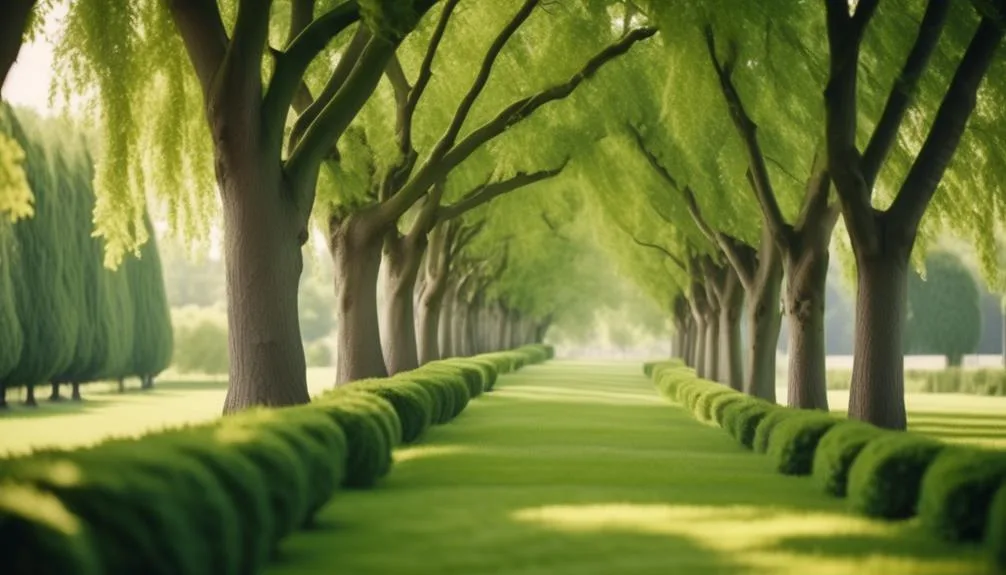Creating an elm tree hedge can turn your yard into a beautiful, natural barrier for privacy and shade. But where do you begin?
Picking the right elm species, finding the best spot, and understanding how to care for your hedge are all important steps.
Let's dive into the process of crafting and maintaining an elm tree hedge that will enhance your surroundings and last for years to come.
Selecting the Right Elm Tree Species
To create a thriving and visually appealing elm tree hedge, it's crucial to carefully select the right elm tree species for your specific location and needs.
When choosing elm trees for your hedge, consider their disease resistance and soil requirements. Some elm species are more resistant to common diseases like Dutch elm disease, which can devastate an entire hedge if not properly managed.
Additionally, different elm species have varying soil preferences, so it's essential to match the tree to your soil type to ensure healthy growth. For example, some elms thrive in well-drained, loamy soils, while others can tolerate clay or sandy soils.
Choosing the Ideal Location for Your Elm Tree Hedge
Select a location for your elm tree hedge that receives ample sunlight and has well-drained soil to promote healthy growth and vitality.
Consider the following factors when choosing the ideal location:
- Soil Preparation: Ensure the soil is well-drained to prevent waterlogging, which can lead to root rot and other diseases. Incorporate organic matter, such as compost, to improve soil structure and fertility.
- Sunlight Requirements: Elm trees thrive in full sunlight, so select a spot that receives at least 6-8 hours of direct sunlight daily for optimal growth and development.
- Disease Resistance, Pest Control: Choose a location that allows for good air circulation around the trees, as this can help prevent common elm tree diseases. Additionally, consider natural pest control methods to maintain the health of your elm tree hedge.
Careful consideration of these factors will contribute to the long-term success of your elm tree hedge.
Planting and Caring for Elm Tree Saplings
Considering the ideal location for your elm tree hedge, you'll now move on to the crucial step of planting and caring for your elm tree saplings.
Start by preparing the soil where you plan to plant the saplings. Ensure the soil is well-drained and rich in organic matter. Elm trees thrive in soil with a slightly acidic to neutral pH level. Dig a hole twice as wide as the root ball and just as deep.
Once the saplings are planted, establish a regular watering schedule. Water the saplings deeply once a week, especially during dry spells. Avoid overwatering, as this can lead to root rot. As the saplings grow, adjust the watering frequency based on the weather conditions and soil moisture.
Proper soil preparation and a consistent watering schedule are crucial for the healthy growth of your elm tree hedge.
Trimming and Shaping Your Elm Tree Hedge
Consider the overall shape and height you desire for your elm tree hedge, as this will guide your trimming and shaping strategy. Proper pruning techniques and shaping methods are essential for maintaining a healthy and visually appealing hedge. Here are some tips to help you with seasonal maintenance and understanding growth patterns:
- Pruning Techniques: Regularly prune the top and sides of the hedge to encourage dense growth and maintain the desired shape. Use sharp, clean tools to make precise cuts and avoid damaging the trees.
- Shaping Methods: Consider using a guide or frame to ensure uniform height and width across the hedge. This will help create a neat and tidy appearance.
- Seasonal Maintenance: Schedule regular maintenance throughout the year, with a focus on removing dead or diseased branches and shaping the hedge to promote healthy growth.
Maintaining and Protecting Your Elm Tree Hedge
Maintain the dense growth and desired shape of your elm tree hedge by implementing proper pruning techniques and regular seasonal maintenance. Protecting your elm tree hedge from pests and diseases is crucial for its health and longevity. Here are some pest control methods and tips for protecting your elm tree hedge from diseases and fungus:
| Pest Control Methods | Protecting from Diseases and Fungus |
|---|---|
| Regular inspection and early detection of pests | Ensure proper air circulation to prevent fungus |
| Use of organic insecticidal soap or neem oil | Avoid overhead watering to prevent leaf diseases |
| Encourage natural predators like ladybugs | Remove and destroy any infected plant material |
| Apply dormant oil in late winter or early spring | Prune out any dead or diseased branches |
| Keep the area around the hedge free of debris | Apply fungicides preventatively if necessary |
Conclusion
With the right care and attention, your elm tree hedge will soon become a beautiful and functional part of your landscape.
Enjoy the process of nurturing its growth and witnessing its natural beauty unfold.
Happy planting!

My interest in trees started when I first saw the giant sequoias in Yosemite.
I was a teenager then, and I remember thinking, “I need to learn more about this.”
That moment stuck with me.
A few years later, I went on to study forestry at Michigan Tech.
Since graduating, I’ve worked in a mix of hands-on tree care and community education.
I’ve spent over ten years helping people understand how to plant, maintain, and protect the trees in their neighborhoods.
I don’t see trees as just part of the landscape.
They are living things that make a real difference in our daily lives.
